Pipe for plumbing in the ground - how to choose and how to
Those who are faced with the problem of laying communications to a house or summer cottage, often have a quite reasonable question, which pipe to use for running water underground. In fact, there is a great option that far exceeds the metal and at the same time has a number of undeniable advantages. We are talking about the HDPE pipe, and we will look at it in our article: let's figure out how to choose a quality option and how to install it correctly.
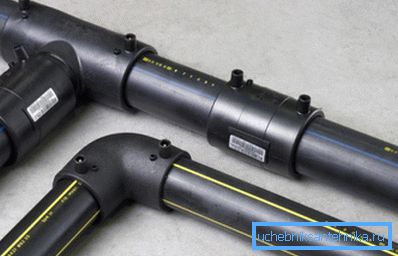
The main advantages of HDPE pipes
To understand why pipe products made of low-pressure polyethylene (the abbreviation is so defined) are so popular, it is necessary to tell about their advantages:
| Corrosion Resistance | Polyethylene is capable of carrying moisture over decades without the slightest damage to material properties. Such pipes do not rust, do not oxidize, which distinguishes them from the metal options |
| Flexibility | Small corners and rather large turns can be laid even without fittings, the elements bend, which makes it easy to bypass obstacles, and in fact, as is well known, the smaller the connections, the higher the reliability of the structure. Fittings are needed only on sharp turns and branches. |
| Strength | Indicators of resistance to deformation are sufficient to lay the pipe at a depth of 1 meter without additional reinforcement, even under car passages. This saves on the lining of trays. In addition, the products are able to withstand an internal pressure of up to 10 atmospheres, which is also important |
| Easy installation | In order to pave the communication, you do not need complicated instructions and the presence of special equipment, everything can be done almost with bare hands, you only need a tool for cutting and chamfering at the ends. Fittings are clamped with their own hands, without the use of any devices |
| Availability | The price of HDPE pipes is very democratic, which makes them affordable for a wide range of customers. This is probably the only option that provides the highest quality at a reasonable cost. |
Note! Another huge advantage of this option is the fact that the products do not burst when they freeze, but stretch slightly. After thawing, the pipe again takes on its original shape.
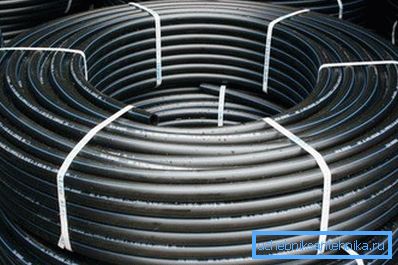
Features of selection and installation
If we have already figured out the question of which pipe is better for a water supply system under the ground, then it’s not so smooth how to choose the highest quality option. Consider this question in more detail.
Pipe selection
It is worth noting that it is better to prepare in advance and even before going to the store to consult with experts about which of the manufacturers represented in your region, produces the highest quality product. You can also search for information on the Internet.
When buying, remember the following recommendations:
- First of all, pay attention to the surface, it should be homogeneous, without scoring and other flaws. Any defect indicates either poor quality raw materials or the use of worn-out equipment.
- Ask the seller for documents confirming the quality of products and their compliance with sanitary standards. The hygienic certificate must explicitly state that the pipes are suitable for drinking systems, and the certificate should state the brand of raw materials; the ideal option is PND pn10, lower brands like pn6 should not be bought, since their characteristics are worse.
- An additional advantage is compliance with the standards of GOST 18599-2001 "Pressure pipes made of polyethylene". The manufacturer marks right on the pipe that it complies with GOST, so it is easy to check the information.
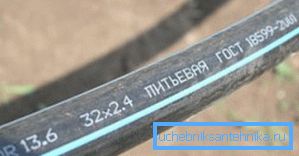
Note! Many manufacturers produce products of a certain color to highlight their brand, and unscrupulous competitors use it, producing pipes under the same color, but the quality leaves much to be desired. Therefore, it is important to always specify who the manufacturer really is.
Pipeline laying
Consideration of how to lay a water pipe under the ground should begin with the fact that it is necessary to study the peculiarities of your region in order to know such indicators as the depth of soil freezing and the recommended depth of laying of communications. The average recommended value is 1.4 meters.
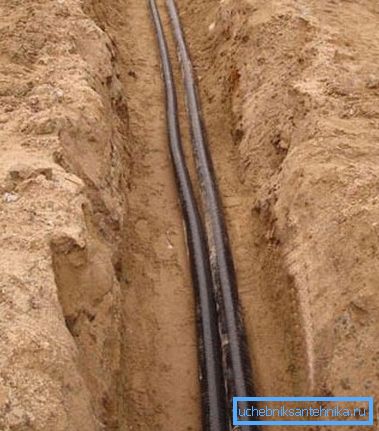
The works themselves are carried out in the following order:
- So that later there is no problem, how to find a water pipe under the ground, it is necessary first of all to make a clear plan, which will reflect all the features of the location. In the future, in case of unforeseen circumstances, the presence of a drawing will save you a lot of time and effort.
- Based on the project, the required number of pipes, as well as fittings and other components are acquired. A clear plan allows you to make calculations as accurately as possible and avoid unnecessary costs.
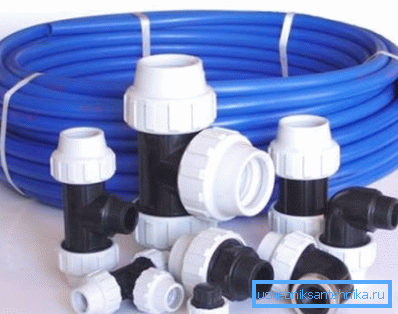
- The laying of a water pipe in the ground begins with the digging of a trench, which must go in such a way as not to intersect with other communications and not pass under buildings. This will allow in the future not to search for water pipes underground at random, you will know exactly how the communications are laid.
- If the depth of the laying is small, thermal insulation of water pipes in the ground will help to avoid freezing, for this it is best to use polyurethane foam products - strong and durable.
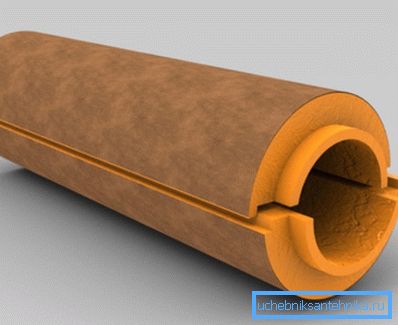
Conclusion
It is possible to lay pipes without assistance, the main thing is to purchase quality products and carry out works in accordance with the recommendations. The video in this article will help to better understand some of the important features of the described process.